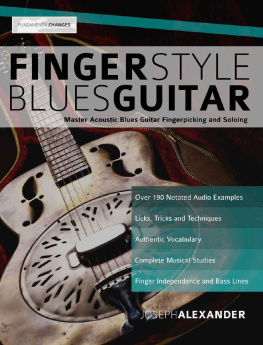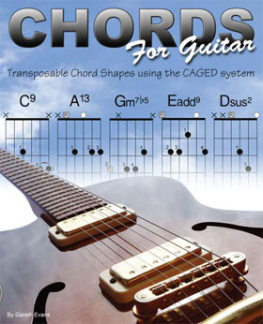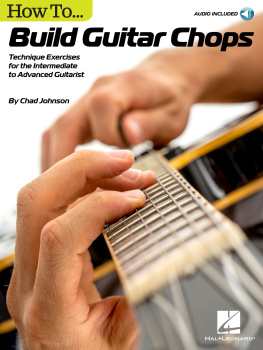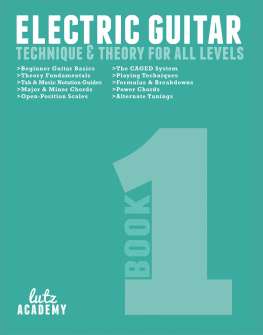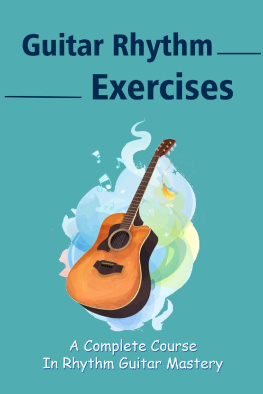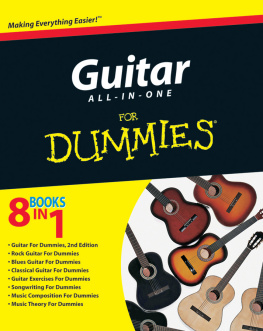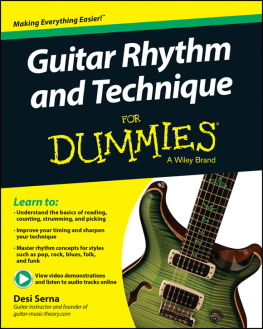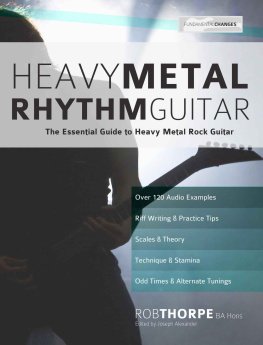The moral right of this author has been asserted.
All rights reserved. No part of this publication may be reproduced, stored in a retrieval system, or transmitted in any form or by any means, without the prior permission in writing of the publisher.
The publisher is not responsible for websites (or their content) that are not owned by the publisher.
FENDER, STRATOCASTER and the distinctive headstock design commonly found on the STRAT guitar are registered trademarks of Fender Musical Instruments Corporation and used herein with express written permission. All rights reserved.
Introduction
There is a common idea among many guitarists that excellent instrumental technique is something that takes years to master. They believe that technique should be put before all else and that it should occupy the majority of your practice time.
In my experience this is not the case, and actually, an over-enthusiastic, single-minded pursuit of perfect technique can be counterproductive, unnecessary, and even damaging to your health.
There is a simple question that you should be asking yourself with regards to technique. Its a question that is obvious but is missed by the majority of guitarists that I teach. When I was first asked this question by my guitar teacher back at the Guitar Institute in London, it floored me, as my teacher had the best technique Id ever seen.
Now, when I ask my own students the same question fifteen years later, they give me the exact same reaction. The question is:
How much technique do you need?
Think about the question, what does it mean to you?
We all pick up the guitar for different reasons. I saw a video of Hendrix at Monterey when I was four years old. That was closely followed by Queen at Live Aid in 85, and then I was hooked. Now I have over forty private guitar students, and on the first lesson I ask each one why they want to play the guitar. I think its important to keep this original goal in mind when we get drawn into an endless spiral of technique practice.
Many students say they want to play music for their friends, some want to write their own stuff, some want to play blues, country, progressive rock or screamo metal.
Some guys are simply honest and say that they want to impress girls!
Whatever the goal is (and if you dont have one, get one), you should certainly consider that the majority of musical styles didnt evolve as a result of technical excellence (with some notable exceptions).
If you want to play blues, for example, you need solid technique. You do not need to spend 8 hours a day practicing only technique; you need to play some blues. If you want to play Dream Theater, you clearly need to spend a lot more time working on technique, but you cant only practice technique, you actually need to learn some Dream Theater songs too.
Learning to play songs is where you discover what technique exercises you need to practice! Simply find out where you get stuck in the song and work out what it is you cant do. Dont make the mistake of thinking that you should have everything in place before you attempt the song.
One of the best players on the planet said, I never practiced technique, I just played songs and tried to figure out what it was that I couldnt do, and why I couldnt do it.
Hopefully that is some food for thought.
All that aside (and because Im certainly not suggesting you dont buy this book!), there is still the misconception that developing good technique takes years of focused and dedicated practice.
That is where this book comes in.
I have been teaching guitar as my full-time job for over eighteen years, and Ive been lucky enough to study under some of the best guitarists in the country. During my career, I have whittled down the list of exercises that I give to my students, to only the ones that give massive benefits, extremely quickly.
As you can probably tell, Im not a massive giver of exercises, but I do see the same fundamental technical problems crop up time and time again. In fact, most of my students will have used most of the exercises in this book to solve most of their technical challenges on the guitar.
These are the exercises that really work. They will address the problems you are having right now, and are probably the reason youre reading this book. If an exercise doesnt look like it will challenge you or teach you something, please skip it. There is never any reason to practice something you can already do.
This book is split into four sections,
- Picking & Finger Independence
- Rhythm
- Legato
- Expressive Techniques
You will sometimes see similar exercises in different sections of the book, albeit with a different focus. There are some finger independence exercises which, for example, make great legato studies due to the finger combinations used. Dont be put off by this; there is no point reinventing the wheel each time we work on a new area of technique. Indeed, when you have studied similar exercises from a new perspective, you will often find a new weakness to work on.
For 90% of you, rhythm and picking should certainly be your first priority. I fully appreciate you may have other challenges, so feel free to dive in where you want.
Remember this though: Your rhythm isnt as good as you think it is. Unless youre Mike Stern, you would benefit from taking a look at the rhythm section first. About 60% of my own practice these days is rhythm. That should tell you something.
I would go as far as to say that the whole point of learning technique, in my eyes, is rhythm and freedom of expression . Most professional guitarists I have spoken to agree entirely, although most would put freedom of expression first.
Speed:
Good technique does not mean playing fast, and playing fast does not mean good technique. There are however certain industry standard tempos you should have in the back of your mind as goals.
Picking:
1/16th notes should be clean at 120bpm. Some would argue 140bpm, and if youre into shred metal, youll probably want to hit 160bpm.
1/16th-note triplets should be at least 100bpm.
Legato:
The skys the limit, so long as every note is defined and even across the beat.
Every example in this book is demonstrated as an audio file. You can download the audio examples from www.fundamental-changes.com/audio-downloads
Dont forget that its normally much more useful to be able to execute any exercise extremely slowly and accurately, than to play it at lightning speed.
Pain:
If you have any pain, stop immediately and see a specialist. If your posture is good and your technique is good you should never experience any pain. The most common reason is that youre trying to play too fast too soon, but you should still stop and see a specialist.
Finally, remember our original goal of musicality. Keep in mind you are what you practice . If you only practice technical exercises, then that is all you will ever play. Learn music.
Joseph Alexander
Get The Audio
The audio files for this book are available to download for free from www.fundamental-changes.com and the link is in the top right corner. Simply select this book title from the drop-down menu and follow the instructions to get the audio.
We recommend that you download the files directly to your computer, not to your tablet and extract them there before adding them to your media library. You can then put them on your tablet, iPod or burn them to CD. On the download page there is a help PDF and we also provide technical support through the form on the download page.


